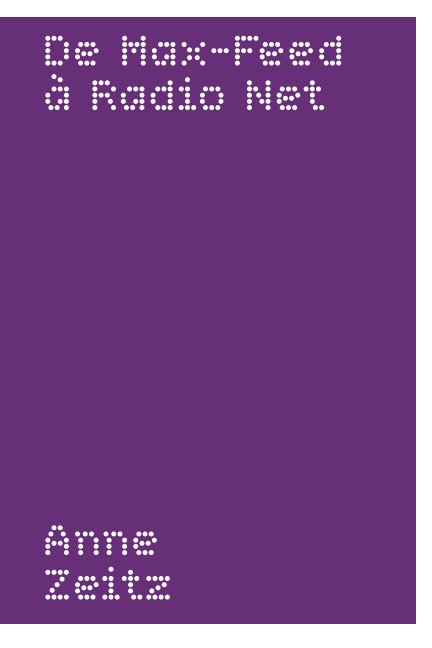Over het boek
De Max-Feed à Radio Net, les projets radio de Max Neuhaus, 48 pages, black and white
Working as a percussionist, notably for John Cage and Karlheinz Stockhausen, Max Neuhaus turned his attention, starting in 1966, to creating objects, walks, installations and sound exchange platforms. If his small electronic object Max-Feed (1966) is still involved with mechanically jamming radio-frequencies, Neuhaus soon turned to the exchange potential inherent in the medium of radio. From then on he produced projects for and with local and national radio stations, such as Public Supply (1966-1973) and Radio Net (1977), by linking their networks to telephone lines. These acoustical experiments which are both anonymous and collective, belong to Neuhaus' interest in the social dimension of both the radio and telephone.
Exerçant en tant que percussionniste, notamment pour John Cage et Karlheinz Stockhausen, Max Neuhaus se concentre dès 1966 sur des productions d’objets, de promenades, d’installations et de plateformes d’échange sonores. Si le petit objet électronique Max-Feed de 1966 insiste encore sur des mécanismes de brouillage des radio-fréquences, Neuhaus se tourne rapidement vers le potentiel d’échange que ce médium représente. Il réalise dès lors des projets pour et avec des stations de radio locales et nationales, tels que Public Supply (1966-1973) et Radio Net (1977), en liant leurs réseaux à des lignes téléphoniques. Ces expériences acoustiques anonymes et collectives s’insèrent dans un intérêt de Neuhaus pour la dimension sociale du médium de la radio et du téléphone.
Working as a percussionist, notably for John Cage and Karlheinz Stockhausen, Max Neuhaus turned his attention, starting in 1966, to creating objects, walks, installations and sound exchange platforms. If his small electronic object Max-Feed (1966) is still involved with mechanically jamming radio-frequencies, Neuhaus soon turned to the exchange potential inherent in the medium of radio. From then on he produced projects for and with local and national radio stations, such as Public Supply (1966-1973) and Radio Net (1977), by linking their networks to telephone lines. These acoustical experiments which are both anonymous and collective, belong to Neuhaus' interest in the social dimension of both the radio and telephone.
Exerçant en tant que percussionniste, notamment pour John Cage et Karlheinz Stockhausen, Max Neuhaus se concentre dès 1966 sur des productions d’objets, de promenades, d’installations et de plateformes d’échange sonores. Si le petit objet électronique Max-Feed de 1966 insiste encore sur des mécanismes de brouillage des radio-fréquences, Neuhaus se tourne rapidement vers le potentiel d’échange que ce médium représente. Il réalise dès lors des projets pour et avec des stations de radio locales et nationales, tels que Public Supply (1966-1973) et Radio Net (1977), en liant leurs réseaux à des lignes téléphoniques. Ces expériences acoustiques anonymes et collectives s’insèrent dans un intérêt de Neuhaus pour la dimension sociale du médium de la radio et du téléphone.
Website van auteur
kenmerken / functionaliteiten & details
- Hoofdcategorie: Kunst & Fotografie
-
Projectoptie: 15×23 cm
Aantal pagina's: 48 - Datum publiceren: jun 30, 2014
- Taal French
- Trefwoorden Network Society, Champs magnétiques, Ligne de transmission, Bande Magnétique, Ondes radio, Phonographe, Radio, téléphone, Oracle, Neuhaus, Max, Antenne, Rétroaction, Ergo-audition
Meer...
Over de maker
Média Médiums
Paris
The Média Médiums collection of books was designed with Jérôme Saint-Loubert Bié to be shown during the exhibition at Ygrec (4 April – 31 May 2014). It consists of theoretical and historical essays and different ways of organising collections of image and text documents. La collection de livres Média Médiums est conçue et réalisée avec Jérôme Saint-Loubert Bié pour l'exposition à Ygrec (4 avril – 31 mai 2014). Elle consiste en des essais théoriques et historiques, et différentes manières d'agencer des collections de documents.

